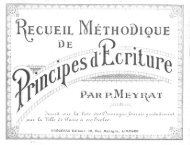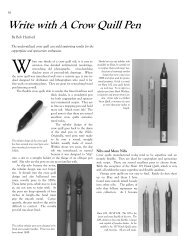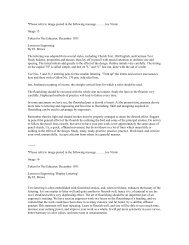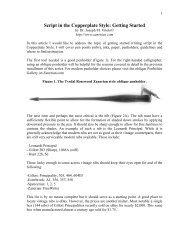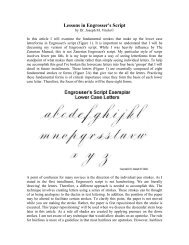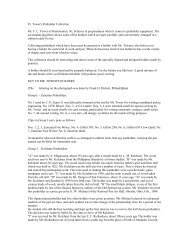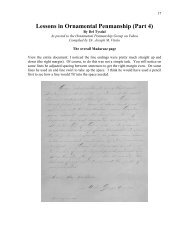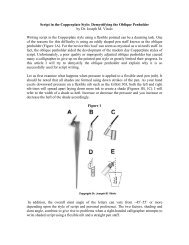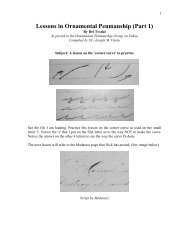The Educator (Volume 45) - IAMPETH
The Educator (Volume 45) - IAMPETH
The Educator (Volume 45) - IAMPETH
You also want an ePaper? Increase the reach of your titles
YUMPU automatically turns print PDFs into web optimized ePapers that Google loves.
'. should<br />
Teaching Letter Forms and Creating Interest<br />
in Handwriting<br />
By MYRA O. HERRICK, State Normal School, Ypsilanti, Mich.<br />
Young people in Junior High School and on through<br />
college get very little encouragement with their writing,<br />
in fact so little is done about it that they are no longer<br />
writing conscious. Practically all that has been accomplished<br />
through the grades is lost. Sometimes they confront<br />
us with the argument that they have to write so<br />
rapidly taking notes in lecture classes that it is impossible<br />
to write well. Of course, notes taken in class are<br />
to be read only by the wi-iter,<br />
each one could use shorthand.<br />
and it would be well if<br />
But when the notes ai-e<br />
to be written up in notebooks either for the instructor's<br />
inspection or for permanent reference, then the writing<br />
be legible and good. It is only courtesy to write<br />
I well when others have to read it. Sometime in our lives<br />
I we<br />
find it necessary to write, and write plainly, if no<br />
j more than to sign checks, and we should know how to do<br />
' it the correct way. <strong>The</strong> old idea that one's signature<br />
I case<br />
should be practically illegible is wrong. Even in the<br />
of attempted forgery, a very plain,<br />
signature is more difficult to imitate than<br />
irregular and illegible.<br />
well-wi-itten<br />
one that is<br />
<strong>The</strong>se are only a few arguments for good writing that<br />
might appeal to the young mind who in this age of typeand<br />
haste has forgotten his grade training in<br />
handwriting and has succumbed to the rather erroneous<br />
idea that good writing is not modern and not necessary.<br />
' writers<br />
<strong>The</strong> handwriting instructor of these modern, young<br />
people should appeal to them with a workable method.<br />
Give them something with which to help themselves.<br />
If one be puzzled as to letter formation, and young<br />
people often are these days, have some scheme whereby<br />
he can test his Jetters and at least approximately correct<br />
forms.<br />
<strong>The</strong> familiar oval or parts of it with the slant stroke<br />
passing through it form parts and in some cases all of<br />
the small letters of our alphabet. Show this to the class<br />
by numbering the important sections as per diagram.<br />
From this figure we get the most commonly used strokes.<br />
y 2 / ,<br />
Strokes<br />
3 ^. 2 / .<br />
3 ^-^/y=yny<br />
3 ^-^/^=X.yU<br />
Sometimes these strokes are longei as in<br />
3^^. 2 /3 ^ -^Jy<br />
Now a student may check his letters with this figure<br />
and reasonably approach correct form. If the letters<br />
slant too much it means they are taking their strokes<br />
from an oval that slants too much. Example of this:<br />
15<br />
Simple classification of heights of letters will aid<br />
students to think in terms of quarter, half and threequarter<br />
space heights. Use the blackboard to show these<br />
illustrations. Draw lines to represent the three-eighths<br />
inch spacing on paper usually used for handwriting lessons.<br />
Show a few quarter-space letters such as i, a, m,<br />
etc. <strong>The</strong>re are eleven of these and five more the same<br />
height above the line but that have one-half space loops<br />
below. Small r and s are slightly taller.<br />
^^ ^y .-t^t^t:^<br />
y^^y y>y yJy-<br />
^T^TTj<br />
Now have the class think of half-space letters. Usually<br />
they find d and t easily, but flounder when trying to find<br />
more of them. Show them small "p", writing the three<br />
letters so the class can see them together. Since there<br />
are only three half-space letters, give the students a key<br />
word which contains those three letters and no other<br />
tall ones, such as the word "stupid". It is helpful and<br />
easy to refer to a key word when in doubt.<br />
Next take up the three-quarter space letters. <strong>The</strong><br />
small "I" forms the foundation for all five of these<br />
1-letters as we may call them. <strong>The</strong> 1 is made first then<br />
something else added to it to make another letter, such as<br />
1 and v combined to make b; I and a hill from an n or<br />
m to make h, I and the loop of the small q to make f.<br />
If the I is not made clearly and well the other 1-letters<br />
viz. b, f, h, k, will be poorly made. That is, make a good<br />
foundation by crossing the two strokes of the 1 at the<br />
height of the small i.<br />
and the resulting letters will be sleek and streamlined<br />
as;<br />
Hy-<br />
when crossed too near the line, the letters will be awkward<br />
and bulky as;<br />
For these three-quarter space letters we can select a<br />
key word which contains all five, such as "halfback",<br />
and which will be easily recalled by the students.<br />
Frequent review of these helps will fix them in mind<br />
so the student will refer to them whenever he finds something<br />
wrong with his letters. It will help make \vm<br />
more wi-iting conscious and independent, and he will have<br />
the feeling of being able to remedy his mistakes, which<br />
is important to the young student as well as to the<br />
teacher.



